There are three ways to take in the photography exhibition, Emerging Taiwanese Cultural Landscape (台灣的模樣): walk through it like a regular show, sit down and enjoy the thoughtfully arranged, multi-panel motion slideshow or browse through the chronologically-organized poster sheets in the hallway.
The National Center for Photography and Images’ latest offering makes full use of the limited space in the three rooms it occupies, pushing beyond the standard format to offer a layered visual and spatial experience. It takes a second to get used to the large projected images constantly moving and zooming in and out in the center of the room, but in the end it makes for a richer viewing process.
The center made an impressive debut in April with Hold the Mirror up to His Gaze (舉起鏡子迎上他的凝視), which drew from over 11,000 works in the collection to present valuable and rare images from Taiwan between 1867 and 1949. Curated by Albert Huang (黃建亮), Emerging Taiwanese Cultural Landscape continues the journey of Taiwan’s photographic history with 350 works from 67 artists made between 1930 and 2010.
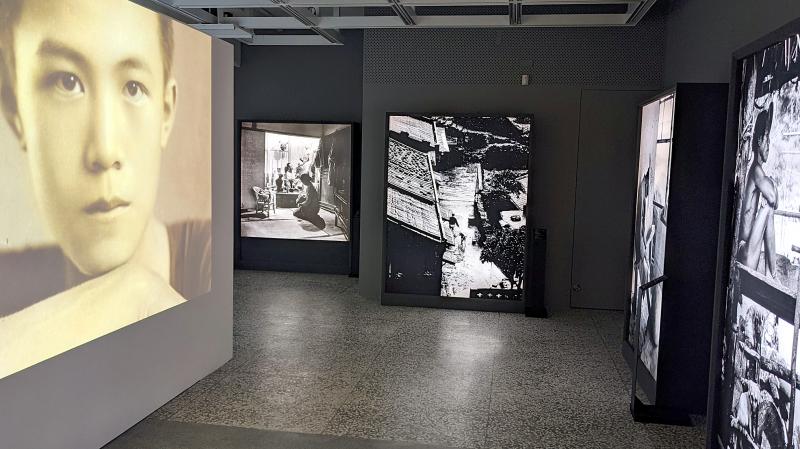
Photo: Han Cheung, Taipei Times
Huang emphasizes that due to political and historical factors, “Taiwanese culture” is still an ambiguous concept that’s yet to be clearly defined. Through the eyes of these photographers of different generations and backgrounds, he hopes to get viewers thinking more about what has made Taiwan what it is today.
“I’m not providing answers, but I hope that each person who views it can have their own reactions,” Huang says. “Quality works make you think, instead of telling you what to think.”
Opening with two color panoramas of Jade Mountain, the exhibit begins with a section called “The Place,” which explores Taiwan’s various literal landscapes, from idyllic rural scenes to temple complexes, urban cityscapes and the canoes of Orchid Island. Many of these are iconic snaps by noted photographers, but there’s also a captivating set from the Wu Jin-miao (吳金淼) photo studio in Taoyuan’s Yangmei District (楊梅), which documented the town’s people and life from the 1930s to the 1980s.
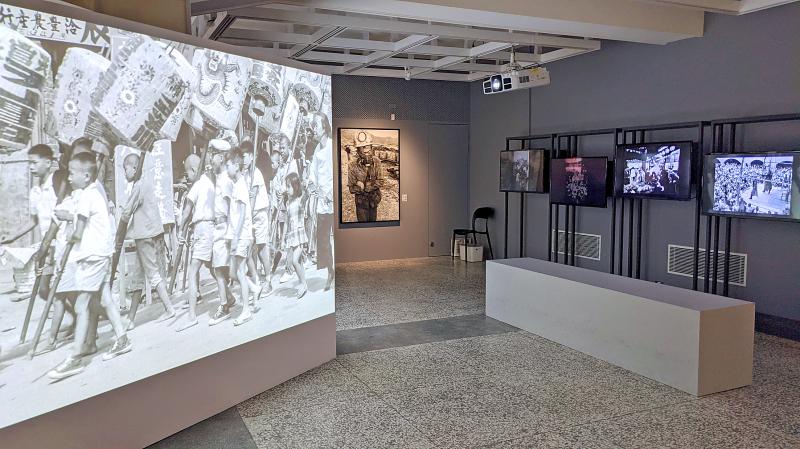
Photo: Han Cheung, Taipei Times
The long hallway leading to the next room features three poster stands divided by era, this part gives the viewer a different feel by being able to physically touch and flip through the works in a completely different configuration. It probably makes more sense to finish the actual exhibition first before returning here.
The next two rooms ramp up the visual impact — in addition to the prints on the wall, many are blown up through lightboxes of various sizes. This is a chance to see some of these iconic photos up close: for example, viewers can clearly spot in Hsieh San-tai’s (謝三泰) snap of children playing with water in the streets of Taipei that there’s a protest going on in the far background and that the water came from anti-riot cannons.
Both rooms have a large, multi-panel surface in the middle where the photos are projected, with seats positioned so that viewers can see two panels at once as a diptych. The images that appear together are mostly related in composition and theme — sometimes even different takes of the same photo, further pushing the viewer toward a unique vantage point.
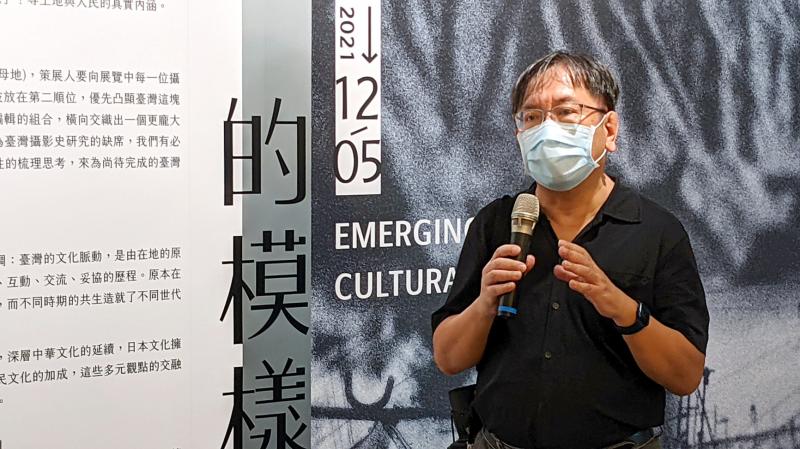
Photo: Han Cheung, Taipei Times
These rooms contain the sections “Rituals,” “The Everyday” and “Events,” which continue the impressive visual journey. Due to the space, however, the “Events” section is condensed to just one wall; there’s excellent material here ranging from comfort women to natural disasters to political, social and labor demonstrations — but it’s just a bit underwhelming as a separate section, and feels like the odd one out compared to the other more conceptual arrangements.
While Taiwan’s cultural landscape still needs much more exploration, the nation’s history of photography also seems to be understated; many of the displayed works are classic shots but most of the names are likely unfamiliar to the average Taiwanese viewer. Huang writes in the exhibition statement that the show purposely focused on the collective context of the pieces instead of the photographers’ creative inspirations to weave a comprehensive overview.
Such overviews are absolutely needed and fitting for the museum’s introductory shows, but it feels that the photographers are too understated. Per the previous exhibition, the description labels are still placed too low and perhaps too small, further obscuring the identities of the creators. Perhaps they could be somehow highlighted on one of the panels, or given some more attention on an interactive display.
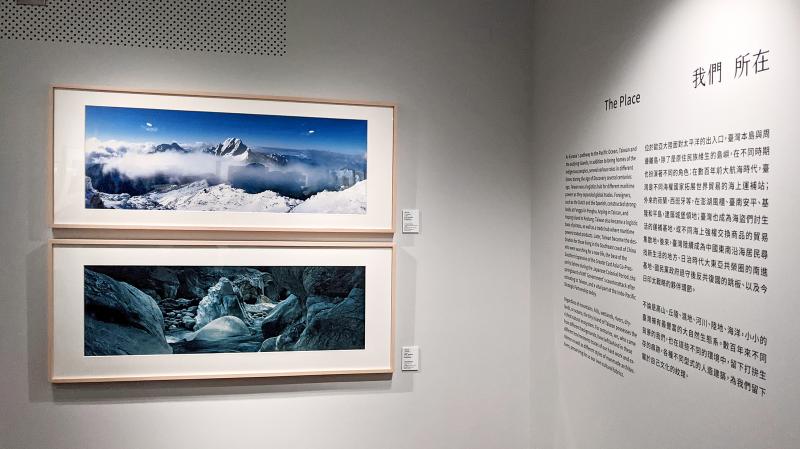
Photo: Han Cheung, Taipei Times
Anyhow, Emerging Taiwanese Cultural Landscape still offers a lot to the general audience, and should be commended for its visual innovations and thoughtfully curated content. It’s exciting to see what the photography center has come out with in just its first few months of existence, and hopefully it continues to provide tantalizing insight into an often overlooked field.
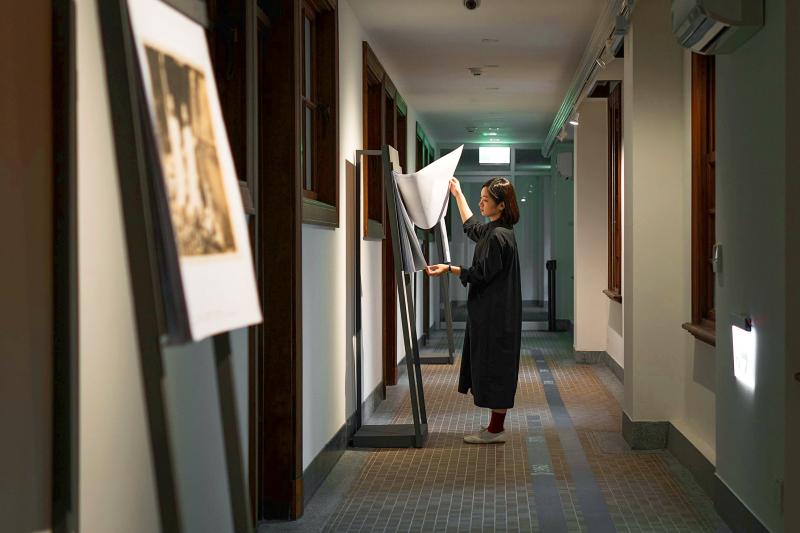
Photo courtesy of National Center for Photography and Images

In the March 9 edition of the Taipei Times a piece by Ninon Godefroy ran with the headine “The quiet, gentle rhythm of Taiwan.” It started with the line “Taiwan is a small, humble place. There is no Eiffel Tower, no pyramids — no singular attraction that draws the world’s attention.” I laughed out loud at that. This was out of no disrespect for the author or the piece, which made some interesting analogies and good points about how both Din Tai Fung’s and Taiwan Semiconductor Manufacturing Co’s (TSMC, 台積電) meticulous attention to detail and quality are not quite up to

April 21 to April 27 Hsieh Er’s (謝娥) political fortunes were rising fast after she got out of jail and joined the Chinese Nationalist Party (KMT) in December 1945. Not only did she hold key positions in various committees, she was elected the only woman on the Taipei City Council and headed to Nanjing in 1946 as the sole Taiwanese female representative to the National Constituent Assembly. With the support of first lady Soong May-ling (宋美齡), she started the Taipei Women’s Association and Taiwan Provincial Women’s Association, where she

Chinese Nationalist Party (KMT) Chairman Eric Chu (朱立倫) hatched a bold plan to charge forward and seize the initiative when he held a protest in front of the Taipei City Prosecutors’ Office. Though risky, because illegal, its success would help tackle at least six problems facing both himself and the KMT. What he did not see coming was Taipei Mayor Chiang Wan-an (將萬安) tripping him up out of the gate. In spite of Chu being the most consequential and successful KMT chairman since the early 2010s — arguably saving the party from financial ruin and restoring its electoral viability —

It is one of the more remarkable facts of Taiwan history that it was never occupied or claimed by any of the numerous kingdoms of southern China — Han or otherwise — that lay just across the water from it. None of their brilliant ministers ever discovered that Taiwan was a “core interest” of the state whose annexation was “inevitable.” As Paul Kua notes in an excellent monograph laying out how the Portuguese gave Taiwan the name “Formosa,” the first Europeans to express an interest in occupying Taiwan were the Spanish. Tonio Andrade in his seminal work, How Taiwan Became Chinese,